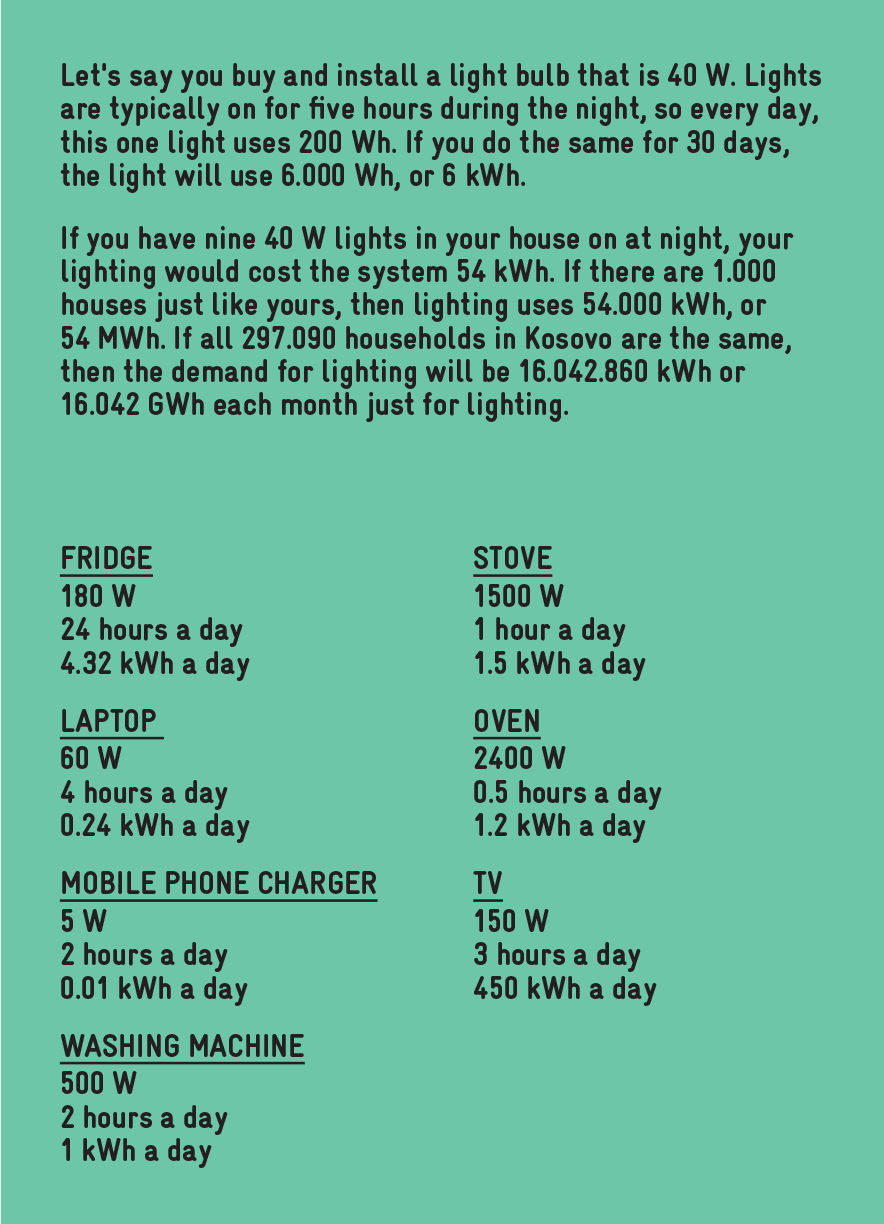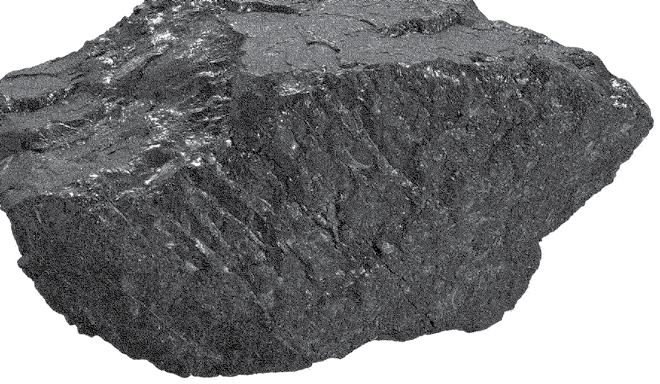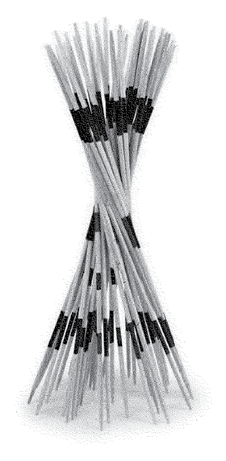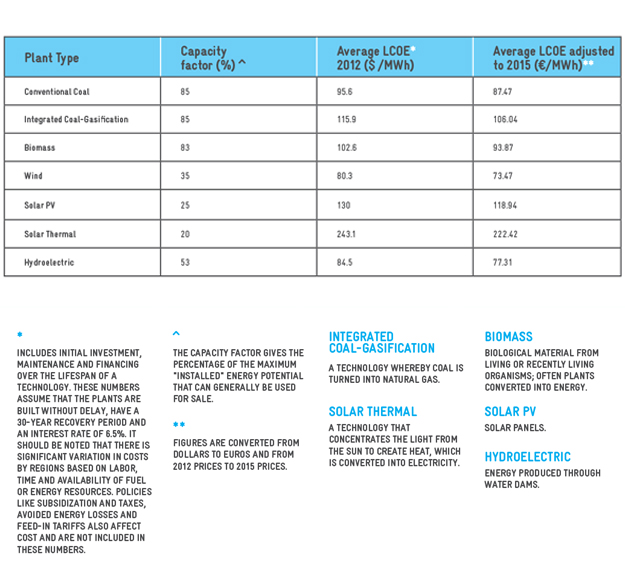Editorial note: This article was originally published in Kosovo 2.0’s Green Issue print magazine in 2015.
Energy is a complex issue in Kosovo, but we can fundamentally agree on one aspect: To move forward and to grow economically, Kosovo needs more reliable energy. The modern world requires power for almost all of our activities, and the systems that provide it are becoming more interrelated. Our environment, our health, our standard of living, even our food system is dependent on energy. And although there is no minimum requirement for human rights (access is defined, not quantity), access to, and affordability of, clean energy sources is of the utmost importance. To get there, we need to have a frank discussion about the options, tradeoffs, costs and effects of the current system, and future possibilities for the energy sector.
The roots of energy
Domestic production of energy comes mainly from electricity (via the lignite plants Kosovo A and B) and from wood fuels. According to the Kosovo Statistics Agency, the nation’s lignite plants produced 5,324 GWh of electricity in 2014. To meet excess demand, an additional 875 GWh was imported. Kosovo also exported 475 GWh, which we’ll discuss shortly. Of the 5,724 GWh net electricity consumption (not including other non-electric energy sources), on average, households consumed 58 percent, high-voltage customers (such as mines) consumed 17 percent and commercial customers consumed 19 percent.
During the process of getting power from producers to consumers, there is a portion that gets “lost” — a category that includes losses from transmission, non-payment and theft, as well as energy lost through inefficient consumption, such as heat escaping from homes. Losses are typically subsidized by all others in the system, meaning consumers who do not pay are subsidized by other customers.
A small number of low-income households receive limited government subsidization, although this fund hasn’t increased for six years, while tariffs have risen. Households that are unable to bring down their debts — including many who should receive social assistance — are cut from the system; they tend to find alternative means of connection or alternative energy sources such as lignite or wood.
Most of the demand for energy resources comes in the winter, when potential alternatives to lignite such as hydroelectric, wind and solar may be less reliable.
The demands for electricity change depending on time of day and how many people are connected and using the system. When demand is low — such as in summer and in the middle of the night — plants that are unable to adjust their production often have a surplus. Therefore, Kosovo can export some energy during these times. Taking into account energy that is available through domestic production and through importing, the maximum amount of power that is generally available to the system in Kosovo during any one-hour period is approximately 1,218 MW. If demand exceeds this amount, it may not be met without incurring significant costs for importing the difference from the wider region.

Imports, natural gas, heavy oil, lignite burned in homes, wood pellets (sawdust and waste wood shavings compacted into small pellets), transportation fuels, solar and wind make up smaller portions of the energy consumed in Kosovo. Other options for heating en masse, such as central and district heating, are available for some areas and buildings. Having a variety of energy sources limits the dependency when the main resources are unavailable or too expensive; however, the limitations of these supplements must also be considered. Most of the demand for energy resources comes in the winter, when potential alternatives to lignite such as hydroelectric, wind and solar may be less reliable.
The debate on improving the availability, security and stability of the electricity system typically revolves around five main areas, and likely a combination of them:
– Building another lignite plant (Kosovo C / RE)
– Rehabilitating Kosovo B and potentially Kosovo A
– Building the renewable electricity stock
– Improving regional energy connections
– Saving, where possible, through energy efficiency measures
Let’s take a closer look at the main pros and cons of these options.
The lignite legacy
Kosovo has the fifth-largest lignite mine in the world. Those who argue for building another lignite power plant say that using these resources would keep production domestic and cheap. It would also create the opportunity to sell surplus energy for export as other regional lignite plants are retired.
Regardless, new and rehabilitated plants would have to meet the EU regulations laid out in Directive 2001/80/EC that cover emissions regulations and heavy metal air pollution. Kosovo is a signatory of the EU Energy Community Treaty, binding the country to EU regulations. Meeting these standards would mean shutting down and replacing Kosovo A — or overhauling it at a cost of 950 million euros — and rehabilitating B by 2017. Kosovo B needs rehabilitation to improve production, meet environmental standards and lengthen its lifespan.

As part of the EU regulations, the planned retirement of Kosovo A is set for 2017. However, the closure of this plant is unlikely to occur on time. It was originally intended to coincide with the start of energy production from the new Kosovo C / RE power plant, or when a reliable alternative could replace and increase domestic energy production. The construction and financing of Kosovo C / RE are still being debated, as are other alternatives, because something needs to replace Kosovo A’s capacity before it can be removed from the supply chain. Without an alternative to Kosovo A, power outages or more reliance on imports would become likely.
The debate on size is also important. Plans for Kosovo C / RE have been significantly downsized since it was originally conceived; current plans are for it to produce around 600 MW per hour. This is the same amount as the combined total produced from Kosovo A’s two remaining turbine units. If the new plant were to be built with six smaller turbine units, they would be able to be turned on and off more easily than, for example, two larger units. This may make planning and shortages easier to address without solely relying on lignite. Given the cost and time of turning on and off units, larger-capacity lignite plants are useful for planned demand, but not for balancing the variability in supply coming from imports.
The green alternative
The main benefits of building the renewable electricity stock are diversifying the energy supply and decreasing environmental costs. The big downsides are cost, availability and balancing supply and demand with available transmission without crashing the entire transmission system.
Renewables need a backup so that when the wind doesn’t blow or the sun isn’t shining, there is still power. Typically this can be overcome through storage (reservoirs, batteries, molten salt), a dynamic transmission system that can offset from other areas producing, and production that you can rapidly turn on and off, such as natural gas, hydropower, or biomass.

The cost of renewables like solar panels and wind are decreasing globally, thanks to wider adoption of the technology and decreased production costs. In places like the US and other areas of Europe, this means that the “levelized costs” — including initial investment, maintenance and financing over the lifespan of a technology — are equal to conventional fossil fuel sources. However, significantly, these areas have higher energy rates than Kosovo. Currently, Kosovo has the second-lowest energy rates in Europe, so there would need to be an increase in rates before the costs of renewables and fossil fuels would be equal here.
Talking turbines
In 2010, the government’s Ministry of Environment and Spatial Planning issued a 10-year spatial plan for Kosovo. In it, the Institute of Spatial Planning discussed the limited studies showing that there is potential for a 45-MW wind park in Zatriqi and another 45-MW wind park in Budakova.
Renewables need a backup so that when the wind doesn’t blow or the sun isn’t shining, there is still power.
However, the plan notes that a factor limiting the further development of domestic wind resources is a lack of reserve capacity to cover times when the wind does not blow or turbines otherwise cannot produce their maximum energy output. If wind production decreased, energy would be need to come quickly from the existing power plants. It is unlikely that the lignite plants would be economically efficient or would have the ability to change production levels. Improvement of the transmission lines and substations near the projected wind turbine sites would also be required.
In a report titled “Kosovo Power Network Analysis for Wind Power Integration and Market Rules Advice,” the firm Economic Consulting Associates discusses “load shedding” (power outages) or short-notice expensive imports as stopgaps if nothing existed to pick up the slack. This would mean direct costs to businesses in terms of lost time, and import costs would go directly into tariffs for the following year, increasing costs for all consumers.
Let the sunshine in
Another report, titled “Sustainable Energy Options for Kosovo” An Analysis of Resource Availability and Cost,” authored by Daniel Kammen, Maryam Mozafari and Daniel Prull of the University of California, Berkeley, covers studies exploring solar panels’ radiation output in Kosovo. According to the analysis, for each square meter of solar panel, it is possible to produce about 1.55 MWh of energy per year. At Kosovo’s 2014 demand of 6,200 GWh, it would need to build 37,575 square meters of panels in order to make a 1-percent impact on the amount of energy consumed. This many panels would cover an area equivalent to 22 percent of Prishtina. It could be accomplished by placing panels on rooftops — though many would need reinforcement — and semi-accessible areas such as by canals or between highway lanes.

However, Kosovo’s solar energy potential and wind technologies face further, similar challenges. These include issues regarding feed-in tariffs, involving how much producers get paid for each kW produced; proper measurement of the resource available, whether it be sun or wind; and the upfront costs of installation. Even solar and wind have not-in-my-backyard issues with land allocation, which often comes at a significant cost. Additionally, large-scale wind hand solar installations have had issues with migratory birds and bats being killed, damaging natural pest control. People living near these systems have reported some adverse health effects, but more research needs to be done as the current evidence is inconclusive.
The Center for Energy and Natural Resources (CENR) is an independent institution that engages parties throughout the energy sector to increase capacity and accomplish academic research. When it was looking into the renewable energy market in 2014, CENR found varied results on costs and availability. One recently installed solar system for a large operator in Kosovo had the capacity to produce up to 15 kW per hour and had a total cost — including installation, battery and monitoring — of 60,530 euros. Household systems are a bit cheaper. Panels range from about 2,000 euros for 2.94 kW per hour to 7,000 euros for 8.64 kW per hour, depending on factors such as where they were made, transportation costs and taxes. The battery system, which is required for storing electricity, costs about 10,000 euros. However, most companies do not keep panels in stock, and installation and maintenance costs depend on the vendor.
Whether Kosovars sign on to buy and install solar panels will depend on several factors, including household income, how houses have been constructed and if they can handle the weight of the panels. CENR found that most homes surveyed in Kosovo rank insulating their homes before purchasing this kind of system in order of importance. With limited funds, the incentives for home solar production are not yet sufficient. Significantly, CENR found that one of the largest energy expenditures here was heating water for showers, laundry and cleaning. This cost could be displaced by household solar water heaters.
The original renewable resource

There’s no ignoring wood fuels as a part of the energy profile of the country. Wood serves as a significant economic solution for heating and cooking needs and can be more reliable in Kosovo than electricity. Often, for households that cannot afford electricity, wood fuels are the primary energy source. Based on research that CENR and the United Nations Food and Agriculture Organization have done on wood fuel consumption, the average household consumes 8.24 cubic meters. This amount varies depending on the location, size, surface area and income of the household, as well as the weather and reliability of electricity in the area. The study estimates that household consumption of wood fuels on an annual basis is approximately 2.1 million cubic meters. Another 217 cubic meters is consumed by schools, bakeries and tourism facilities.
Previous research on the Kosovar forest sector, done by the Norwegian Forestry Group and the Ministry of Agriculture, Forests and Rural Development, estimates that a sustainable long-term harvest level is closer to 1.2 million to 1.3 million cubic meters. It also suggests that more than 90 percent of the volume harvested is not done so in accordance with local regulations. The research highlights the high level of dependency on wood in Kosovo. Without changes, this dependence will lead to the rapid disappearance of Kosovo’s forests. Unofficial estimates have this occurring at some point in the next 15 to 20 years.
There are a couple of caveats to estimating wood fuel demand. It’s difficult to estimate the true amount of illegal harvesting and cross-border trading that is going on. Pair this with the other demands for the forest in terms of valuable products — timber for furniture and other higher-value options — and regulatory issues with harvesting times, tenders and a lack of replanting, and the estimate can be assumed to be, if anything, on the conservative side. Kosovo’s forests may be even less sustainable than we think.
The forestry sector needs attention, especially when we talk about energy consumption, prices and alternatives. This means that the original renewable resource is being overharvested, and the households that are dependent on this resource for heat, cooking and water heating will be at a significant disadvantage as electricity prices increase.
Wiser wood
One solution may be going to more efficient uses of wood, such as wood pellets. In 2014, CENR found that there was a wide range of wood pellet-burning stoves available, starting from 1,600 euros for a small stove capable of generating 12 kW per hour, to 35,000 euros for a 600-kW stove that would typically be used for central heating. On average, a household may need 4 tons of pellets a year, with each ton costing about 180 euros. Unfortunately, for most villages, wood pellet stoves may be less useful than the traditional wood stoves that CENR typically found in low-income areas because they provide heat, a cooking surface and the ability to warm water. Additionally, non-transparent marketing and issues with raw materials and certification mean that this is not yet a sustainable option.

Working with the neighbors
Another way to change the electricity mix is to import more from the surrounding region. According to the Economic Consulting Associates, in 2012, load-shedding in the form of scheduled power cuts was used to manage the supply for more than 1,300 hours (15 percent of the year), totaling 145 GWh. Through a temporary agreement, load-frequency-control management for the Kosovo system is currently provided by a Belgrade-based company called EMS Serbia. According to the Energy Regulatory Office (ERO) annual report for 2014, 85 percent of Kosovo’s imported energy came from Serbia, though more was transmitted through to other countries, increasing the regional importance of the Kosovo-Serbia relationship. This agreement is potentially an issue when considering regional politics.
When considering possible imports from Albania, Kosovo typically imports when there is a surplus of electricity generated by Albania’s hydroelectric dams. However, this is only feasible when there is water in the system, in spring and summer. Imports from Albania are usually offset by exports from Kosovo at other times of the year, during times of low domestic demand.
There are two other key points to consider concerning the connections between the Albanian and Kosovar energy systems. First, different weather patterns may affect hydroelectric resources. Second, there is competition on the international market. When the 1,000-MW line between Albania or Montenegro and Italy is finished, there will be a direct line from the Balkans to the European transmission system, known as ENTSO-E, and therefore to European demand. Kosovo is already aligned within this system, along with the other countries in the region.

Energy, much like water, will flow in the path of least resistance — to its best-paying customer. Ideally, this competition — a main component of EU market liberalization — will make it so that prices come closer to parity, as there is no difference between a kW produced from lignite or water, or from any country, once it’s transmitted. Economically, this means that prices will drop in some areas. For Kosovo, however, the price is likely to rise as the ENTSO-E energy system moves the Balkans toward a single energy market. This is because, according to the EU policy paper “Bringing Europe and Third Countries Closer Together Through Renewable Energies,” Kosovo has the lowest prices in the region. This is likely to be a result of the heavy subsidization of energy prices in Kosovo, which will be costly to maintain with more competitive markets.
When shopping the international market, the best price is the one that you can get before you need the energy — much like purchasing wood for winter in May, when prices are lower than in December. Once electricity is produced, it has to be consumed; therefore, matching supply and demand is critical in preventing losses. However, the energy demand in Kosovo is not fully known with certainty, thanks in part to meters being tampered with and illegal connections to the system. Demand is currently modeled based on assumptions, not real-time consumption.
If KEDS, the distribution supply company that is responsible for purchasing the electricity, knows how much it’s going to need to purchase in the future, it can get a better price, especially for winter when there are high demand, high prices, and limited regional supplies. KEDS has been installing digital meters in an effort to measure demand in real-time. In many other developed countries, digital meters have been used to better manage the daily demand by shifting or cycling consumption and implementing more time-reflective rates.
When the 1,000-MW line between Albania or Montenegro and Italy is finished, there will be a direct line from the Balkans to the European transmission system, known as ENTSO-E, and therefore to European demand.
In Kosovo, there has been controversy over whether the meters are measuring correctly, a regulatory responsibility of the Ministry of Trade and Industry Metering Agency. It is in the long-term interest of those planning and purchasing electricity in the system to ensure that these meters are reliable. With correct measurements, KEDS could propose a more diverse rate system. For example, instead of just having day and night rates, it could introduce off-peak and average categories, allowing households to shift their energy consumption in order to save money.
The ERO reported that while the average price per MWh of imported electricity — including through commercial contracts — was decreasing in 2014, Kosovo’s demand was rapidly increasing.
When exporting electricity out of Kosovo, there are three main avenues: contracts, pushing power and swapping power. Pushing power means there is no contract, and the electricity is dumped on the regional market at a price of about 20 euros per MW. Swapping power means another country imports power during part of the day, and the equal amount is exported during another part of the day or week.
Additionally, all of these regional connections and relative prices depend on what is available within the region. Roxanne Sturatgar, a former USAID energy specialist, noted the problem in February 2012, when the severity of winter storms increased demand to the point that even the US Embassy was rationing power. If electricity could be found at all, the import cost was 300 euros per MW. Kosovo can either hope for warmer winters or figure out how to meet its increasing energy demands.
Until residents understand energy costs and how their behavior and use of appliances affect bills and consumption, there is little that can be done to decrease the amount of energy used annually.
What a waste
Energy efficiency can be thought of in three functions: heating and insulation; electrical appliances; and behaviors. Currently, most Kosovars use wood to heat their homes — or often, just single rooms within their homes — which tends to be cheaper than using electricity. The upfront costs of insulating the home effectively can be prohibitive. Also, given the small amount of space currently being heated in many homes, the benefits of insulating the whole house would accrue over a much longer timespan than if the same residents were heating their whole homes or were using electricity for heat.
There are several inefficient electrical appliances left from former-Yugoslavian times that do not meet today’s efficiency standards. In order to get them out of circulation, a buyback program would probably be required.
Lastly, people need to understand their consumption. Until residents understand energy costs and how their behavior and use of appliances affect bills and consumption, there is little that can be done to decrease the amount of energy used annually.
A pocketbook issue
Before we look at what these different energy solutions might cost Kosovo, we first need to understand how energy is charged to consumers.
The affordability of energy to consumers is equally important to the cost of energy production, but is not well understood by most people. The rate structure is currently designed so that household consumers are incentivized to use less. The monthly tariff blocks are 0-200 kWh, 200-600 kWh and greater than 600 kWh. The more you use, the higher your bill. Households not using electricity to heat their homes can have bills under 200 kWh and pay less than 11 euros per month. Consumption is determined by the number of people in the home, as well as the use of appliances their running costs. Residents can save more money by using more efficient appliances or by switching to alternative heating sources to lower costs.
One benefit of the rate system is that households can use the cheaper tariffs at night for passive activities like heating water and space, running washing machines and charging cell phones. If the water heater and home are well insulated, the heat is retained for the more expensive daytime hours. One resident interviewed through the CENR in Fushe Kosova said that, with the insulation on his house, he could heat his home and it would remain warm for three days.
There is a suggestion that the rate structure could be simplified in order to help households to better understand their bills. One option discussed by the Kosovo Civil Society Consortium for Sustainable Development in “A Policy Solution for the Energy Sector in Kosovo,” would be to replace the current system — which has different day, night and seasonal costs for each of the three tariff blocks — with a single tariff.
However, this would affect the distribution of costs among consumers. According to KEDS, the current lowest tariff block represents about 33 percent of Kosovo’s households, while the highest tariff block represents about 26 percent. It is the middle tariff (200-600 kWh) that best reflects the true production and import costs for the system. This means that there is currently an implicit subsidy for low-consuming households, who pay less than the true cost of energy production, by the high-consuming households, who pay more than the true cost. Moving to a single tariff would shift the costs from high-consumers to low-consumers and decrease the incentives to be more efficient.
But what’s it going to cost?
So, how can we rank the energy options that are available? For most consumers and market operators, it comes down to the issue of cost. The US Energy Information Agency publishes an annual report on the costs of new production to supply energy.
These expenses are the estimated levelized costs of electricity (LCOE) — which include costs for initial investment, maintenance and financing over the lifespan of a technology — for new generation resources by 2019.
Here are the likely options for Kosovo.

Translating this to the consumer means that for a new lignite plant, the cost per kWh given the current rate structure — for the middle tariff block of 200-600 kWh of consumption — during the day, in the summer, would be about 0.087 euros per kWh. Given regional variations in costs, and generally stricter environmental standards in Europe than worldwide, it could actually cost more in Kosovo than the table suggests. It is estimated that Kosovo RE / C would cost approximately 0.092 euros per kWh.
Wind would be cheapest, at 0.073 euros per kWh, but its capacity to produce is only at 35 percent of the installed capacity, because the wind doesn’t always blow. The costs of its backup would also need to be considered. The current ERO tariff rate is 0.0542 euros per kWh during daytime in the summer. This means that even if there was enough hydro, wind or solar capacity, prices would increase for the consumer. Given the need to find alternative supply options to supplement hydro, wind or solar, the current cheapest tariffs would likely be doubled.
Higher energy prices are inevitable. However, with the way the system has been privatized, KEDS can go searching for the cheapest electricity to purchase on the international market. It is legally compelled to purchase from any domestic capacity with feed-in tariffs; KEDS already purchases energy from the wind turbines near Prishtina Airport and from a small solar farm in the north of Kosovo. Additionally, the ERO has the incentives and ability to adjust prices and to subsidize or tax the production and purchase of electricity.
Increased forest harvesting would likely lead to more soil erosion, and the Institute of Spatial Planning has reported that 50 percent of Kosovo’s land is already facing the highest erosion rates measured.
Energy always has tradeoffs, regardless of the system that produces it.
Lignite has well-documented health effects, whether burning it at home or in a power plant. According to the World Bank’s 2013 Country Environmental Analysis, the main pollutants caused by burning lignite in plants and in homes are particulate matter or dust, sulfur dioxide, nitrogen oxide, carbon dioxide and lead, all of which were over EU limits. Such limits are set to prevent or reduce harmful effects on people. These pollutants can lead to respiratory and cardiovascular conditions in the short term and chronic lung and heart conditions, including cancer, with long-term exposure, contributing to the lower life expectancy in Kosovo compared with other European countries.
If people are burning lignite in their homes, they do not have filtration systems — hence the metallic taste you get wandering the streets in the winter. Filtration and environmental control systems have a cost as well, and it multiplies as more are installed. Power plants with larger units require fewer filtration systems and spread the environmental costs over more MW produced, thus decreasing the per-kWh price for consumers. Plants with smaller units need more filtration systems, so costs increase. The same would be true for installing filtration in households.
We’ve already talked about the alarming rate of deforestation caused in part by the wood fuel energy sector. Increased forest harvesting would likely lead to more soil erosion, and the Institute of Spatial Planning has reported that 50 percent of Kosovo’s land is already facing the highest erosion rates measured. This means fewer nutrients for farming or for regrowing the forest stock, as once topsoil is gone, it takes hundreds of years to replenish. Additionally, fewer trees results in less capture of carbon dioxide, one of the biggest contributors to human-caused climate change.
Kosovo, like all countries, has an obligation to provide its citizens with energy, and must consider the limited financial resources available. From an economic perspective, is Kosovo in a position to give a lot of consideration to environmental considerations? But from an environmental perspective, can it afford not to?
Finding a balance
The questions remain: What is available? Which tradeoffs does society want to make? Whichever solution is pursued for the future of Kosovo’s energy, all of the options available will increase costs.
Higher prices typically persuade people to alter their consumption by making investments in energy efficiency, reducing waste and changing to alternative energy sources. As prices rise, it’s likely that more people will start insulating their homes, changing to more efficient appliances and moving away from electricity to alternatives such as wood, gas and lignite. However, these alternative energy sources may be just as unsustainable as continuing on the current path.
Households that have the available capital, possibly through diaspora funds, may have the option to substitute a portion of their energy consumption with solar systems or improve the efficiency of the household. The key with any of these alternatives is for people to use their resources with efficiency, such as keeping stoves maintained and not opening windows to let out heat.. This requires more education and access to better tools and resources.
Kosovo is playing catch-up for years of neglect in the energy system, the state of the economy, and a lack of insulated homes and efficient appliances. The question of affordability needs to be addressed, whether by developing social safety nets for the poor to improve their efficiency or through subsidizing prices. However, the most expensive thing for Kosovars is not having reliable power. It costs businesses. It costs jobs. It costs the economy as a whole.K
The Human Dimension
To bring the human dimension to some of these numbers, a household can spend an average of 17 percent of its income on energy (including wood fuels). CENR’s research unveiled cases where the proportion of income spent on energy was more than 28 percent, and as low as 5 percent. Some of the 605 households that CENR interviewed in its most recent survey indicated that to decrease their bills they’ve gone as far as washing their laundry by hand with hot water boiled on their wood stoves, because they can’t afford to run the washing machine. In Fushe Kosove, one person told CENR, “Why would I pay for wood or electricity when I can dig in my backyard and find lignite?” — while also telling of the health problems of burning coal. Another resident told of his 100-euro salary and not being able to afford his heart medication or bread for his family, all while the walls in his three-room house rotted due to leaking water.
Often these households are barely educated past elementary school and have few, if any, extended family members (a typical non-governmental safety net). These are also the households that are likely to be particularly dependent on their environment; issues such as climate change, deforestation and environmental health issues are likely to affect them significantly, as they have limited ability to respond to changes or to insure against costs. Policies like improving forest regulations and protecting forest resources will help to sustain this part of the population, while debating the future of the energy system and drivers of economic growth will also aid them.
Illustrations by Van Lennep.










